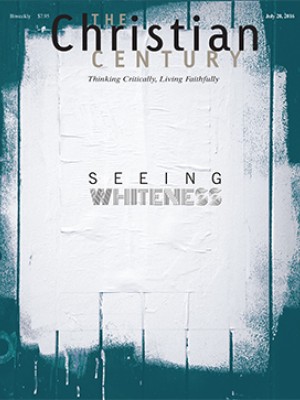Seeing whiteness: Exercises in understanding race
I used to lead activities like the "Privilege Walk" and "Cross the Line." I couldn't shake the feeling that they were not taking us very far.

When I worked in the residence life department at a predominantly white Christian college, I was responsible for conducting an annual racial diversity workshop for staff members and student leaders. I became familiar with a few standard workshop activities, most notably one called the Privilege Walk and one called Cross the Line. Both exercises offer participants the opportunity to reflect critically on some aspects of diversity. But I soon learned that these exercises have some drawbacks and may actually obscure or reinforce some of the problems that racial diversity training should expose.
In the Privilege Walk, participants begin standing side by side at a starting line, with the finish line about ten paces ahead. The facilitator then reads a series of statements. If a participant’s experience corresponds with a statement, he or she takes one or more steps forward as directed. A statement may be “It was assumed from a young age that you would go to college” or “You don’t have to worry about helping your parents out when they retire” or “You never think twice about calling the police when trouble occurs.” The exercise ends when all of the statements have been read.
Read our latest issue or browse back issues.
Typically, at the end of the activity a white male has crossed the finish line far ahead of everyone else, while people of color are gathered closer to the start, and at least one person of color is left at the starting line. People who are in line to win the race are meant to recognize that their success is the result of unearned privilege.
In Cross the Line, participants also stand side by side and are asked to respond honestly to a series of statements that generally have less to do with race and more to do with other kinds of social differences. Participants who identify with a statement must risk being honest and get out of line to face the crowd. You are asked to cross the line if you’re adopted or if your natural parents are divorced or if you’ve experienced the effects of drug addiction in your family.
After three years of leading these exercises and the conversations that followed, I couldn’t shake the feeling that the activities were not taking us very far in confronting the real issues of race. The Privilege Walk could reinforce negative stereotypes and evoke a sense of isolation among people of color. In the debriefing period for both these exercises, participants usually reflected on their personal feelings about privilege, or how they felt about crossing the line and seeing others do so. This engagement with difference ended up reinforcing the notion that problems with diversity are primarily affective and can be addressed at the level of individual feelings. The apparent lesson is: “Don’t be hostile toward others, choose tolerance, and embrace the differences among us.”
But the story of race is about much more than our feelings toward one another, or about differences that we can fix with talk of tolerance or color blindness. The story of race is an ideology of difference that shapes our understanding of our selves, the world we inhabit, and the communities that we inhabit or want. As an ideology, racial thinking assigns value to human beings who are grouped within artificial categories based on aesthetic features. In teaching participants to embrace differences, we may end up accepting stereotyped understandings and artificial hierarchies. What is needed is not an embrace of contrived notions of racial differences, but a critical examination of them.
These popular exercises don’t do much to expose this root cause of social hierarchy and oppression or to address how race actually works.
Furthermore, scholars of race have identified the creation of whiteness as foundational for the creation of racial categories. These exercises don’t address the issue of whiteness and the challenge of learning to see whiteness.
Historically, overtly racist regimes have been explicit about their use of whiteness as an organizing principle. The violent Jim Crow “whites only” South, Nazi Germany’s embrace of the ideal Aryan, and apartheid South Africa’s “whites only” regime were born of an ideology that fetishized white humanity and white community. Media coverage of racist violence during the civil rights movement helped paint overt racism in a negative light and made it no longer socially acceptable to be openly racist. Yet it did not erase the ideology that makes white people the ideal form of humanity—the very ideology that renders logical the pursuit of “whites only” society. What is needed in conversations about racial diversity is a targeted encounter with unexamined whiteness and how it continues to serve as the governing ideology of human difference.
In conversations with students and white colleagues, I developed two exercises meant to highlight the invisible ways that race continues to factor into our interpretations of each other. One activity is for the classroom and the other is for larger group settings. They are both word-association activities that are meant to work like a racial Rorschach test, revealing the way race distorts our understanding of one another.
In the classroom exercise, everyone is given a piece of paper and a pencil. The instructions are simple: don’t put your name on the paper, listen carefully to the questions, don’t say anything out loud, and don’t write anything until asked. I then ask the students to reflect on what comes to mind when I say “Asian people.” I give people a few moments to think and then ask them to write down their response. I then ask the same question with regard to Mexican people and then Arab people, Indian people, and black people.
At the end I ask them to write down what comes to mind when I say “white people.” It’s helpful to ask this question last because white is often the most challenging category to describe. It is the backdrop against which all the other categories of race are seen. Whiteness functions as a social-political organizing norm, arranging all of humanity according to proximity to the template of the ideal white human. Yet it remains invisible to most white people, so whites struggle especially hard to describe it. By asking them to write about white people I’m inviting them to wrestle with making whiteness apparent.
A way to do this activity with a larger group is to set up a table with boxes, each labeled with a racial group. Along with each box are sheets of paper and pencils. Participants are instructed to write a word or a phrase that comes to mind for the racial group named on the box, and they are told not to put their name on the paper. At the end, the responses can be read aloud—using discretion about what should not be read aloud—and chronicled on an easel pad for everyone to see.
This exercise highlights the regulated understanding of humanity in the collective imagination of the room. People can see their thoughts next to those of others—a transparency that is unlikely to arise in conversation.
In doing this exercise I’ve found that undergraduates in a small Texas town share many of the same racial interpretations as graduate students in Chicago. The label Latino or Hispanic elicits associations such as “illegal immigrant,” “farmers,” “sometimes treated unfairly.” Middle Eastern people prompt phrases like “radical Islam,” “terrorism,” “tough to be a woman.” The label Asian evokes “good at math,” “poor drivers,” “stoic and unfeeling.” Black people are associated with “music,” “dancing,” “prison,” “athletes,” “angry.” Once, a student submitted the phrase “I will only like one of you” to the box labeled Middle Easterner. It took some time for people to realize that the student was a Christian and was naming Jesus as the only Middle Eastern person he or she found tolerable.
In both versions of the activity, I read aloud responses to the category for white people last. It’s common to get words like “normal,” “nonethnic,” and “no race” for white people. (I’ve also gotten “sweater vests” and “George Clooney.”) The exercise reveals that normal humanity, regulative humanity, or template humanity is white humanity. That is the enduring ideology of white supremacy: white as normal humanity.
Historically, the descriptions for people of color developed as white racial identity was itself being established. First came the transatlantic slave trade, and then came the scientific language of race, which helped organize Western societies around that very lucrative practice. Race is a myth biologically, but it is a political reality. Racism is the effort to create and sustain systems and structures for whites. Race is a financially incentivized anthropology designed to legitimize the buying, selling, and owning of African bodies.
The racial Rorschach activity taps into subconscious audio files that are always on autoplay in our psyche. The power of white-as-normal is so common that it regulates social and political structures, often without participants recognizing that they are its willing disciples. White-as-normal shapes what is believed to be civilized behavior.
Historical depictions of Jesus and of God as white render this regulating practice as sacred, giving religious justification to the normative role of whiteness. Those of us who aspire to do justice, to love mercy, to walk humbly with God, and to follow Jesus are called to reveal and to arrest the enduring ideology of white supremacy.






